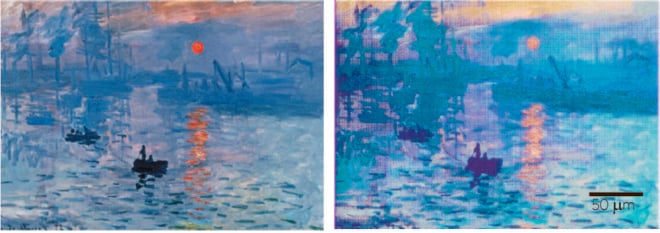
A new version of Impression, Sunrise that is surely the world’s tiniest Monet may be a precursor to sophisticated anti-counterfeiting technology enabled by nano-printers, reports Gizmodo.
The new, ink-less printing method, developed by researchers at Singapore’s Institute of Materials Research and Engineering, sounds incredibly complicated, and involves aluminum nanodisks stacked on top of microscopic pillars, layered atop a silicone substrate. Beams of electrons are shot at the nanodisks, which, based on their diameter, will reflect different visible light frequencies, producing a range of up to 300 colors.
The Monet test image is a mere 300 microns wide (aka three times as wide as that comic printed on a single strand of hair), but offers an astounding 30,000-dots-per-inch resolution, which gives new meaning to the term “Pointillism.” “A single drop of dye from a typical printer would already be about the size of the entire print made with our technology,” Singapore University of Technology and Design assistant professor Joel K.W. Yang told Wired.
The nano-printer isn’t the only unconventional means by which modern technology now allows us to create faux-Monets. As reported by the Creators Project, the new app Psykopaint offers “photo realistic brushes” that give you the ability to replicate the appearance of pencil, watercolor, spray paint, and other media on three difference surfaces: wood, canvas, and paper.
You can start from scratch, or overlay your work on top of an existing photo, quickly and easily transforming your summer vacation snapshots into authentic-looking works of art.
The app comes pre-loaded with settings for such masters as Gauguin, Van Gogh, and yes, Monet, but what sets it apart is its ability to digitally render how your creations would appear in real life. The colors change as if in response to real reflected light as your tilt your tablet back and forth (see above).